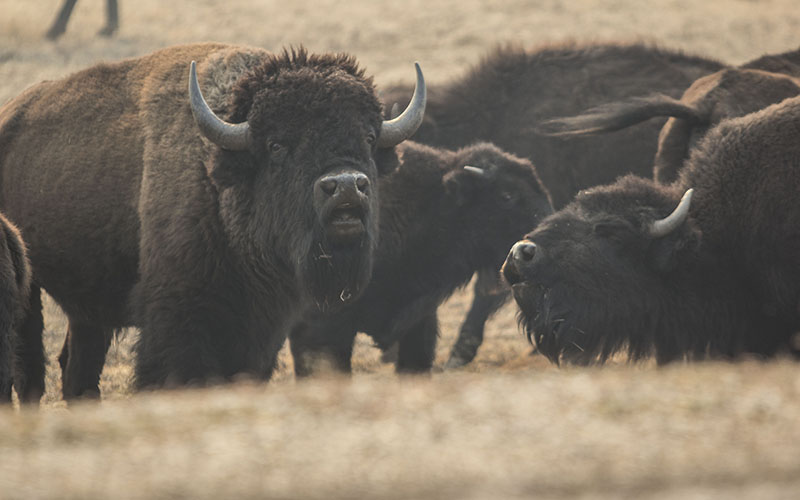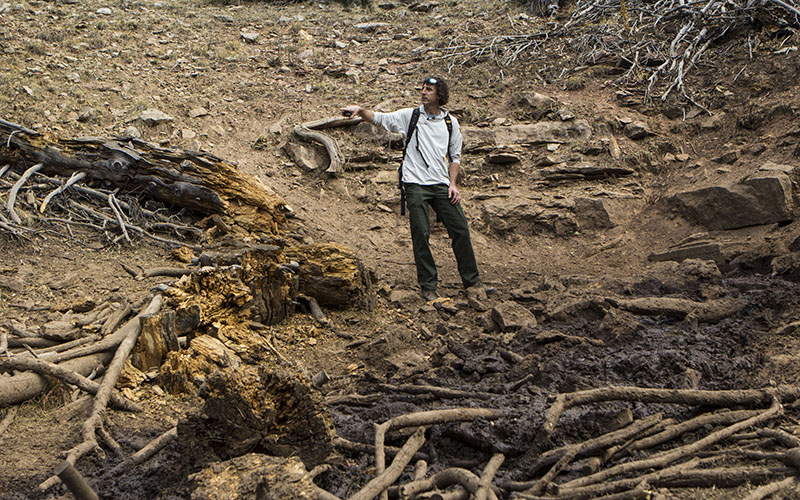- Slug: BC-CNS-Buffalo Shuffle,770
- 3 photos available (thumbnails, captions below)
By Ulysse Bex
Cronkite News
WASHINGTON – A planned hunt of bison on the North Rim of the Grand Canyon this week appears to be moving forward, despite last-minute pleas by lawmakers in Colorado to move the animals there instead.
The hunt, which has been in the works for months, is just one way the National Park Service hopes to reduce the size of the herd, from about 600 bison now to 200 by 2025, a number that wildlife officials say could live in the park without causing environmental damage.
More than 45,000 people applied to be one of the 12 sharpshooters who will be selected for the hunt, a pilot program that will mark the first time hunting is allowed within the confines of the park.
Environmentalists agree that there are too many bison for the health of the park, but they question the value of killing just 12. Instead, Colorado Gov. Jared Polis said that the animals should be moved to his state, where they can “live and roam free at the Southern Plains Land Trust in Bent County.”
“I urge Interior and the National Park Service to consider this practical Colorado situation,” Polis said in a statement Tuesday.
His statement followed a letter to Interior Secretary Deb Haaland last week from Rep. Joe Neguse, D-Colo., and four other House members urging the department to consider “non-lethal methods to manage the bison population, such as the use of live capture, a fertility control vaccine, etc.”
Calls to federal and state officials overseeing the hunt were not returned Wednesday. But in previous documents on the herd management plan, the National Park Service rejected bison birth control, citing the need to quickly reduce the size of the herd.
“Fertility control can take a long time and requires expensive, frequently repeated applications to achieve significant population reductions,” said the service, adding that other methods, including “lethal removal” will get the herd to the desired size in the next few years.
But critics of the lethal removal plan, who said Wednesday that they had gotten no indications that the hunt was being delayed, said the pilot program is not only wrong, but the wrong way for the park service to achieve its goal.
“The idea that killing 12 of them (bison) is going to get you close to bringing it down to 200 is ridiculous,” said Joe Trudeau, a Southwest conservation advocate at the Center for Biological Diversity. He said the center “absolutely supports the request of Gov. Polis – it’s humane, it’s logical and it’s realistic.”
The hunt is part of an agreement reached last year between the Arizona Game and Fish Department and the National Park Service, to reduce the bison herd on the North Rim of Grand Canyon National Park. Without management, officials estimate that the herd could grow from about 600 animals today to as many as 1,500 in 10 years.
In addition to lethal removal, the plan calls for hazing bison in the park and for live capture of bison that can then be transferred to Native American tribes to manage. As of this month, a total of 124 bison had been removed from the park over the last two years and transferred to six tribes, in four states, that are part of the InterTribal Buffalo Council.
But the hunt has drawn the most attention. From the more than 45,000 applications received, the Arizona Game and Fish was to select a final 12 “skilled volunteers” for the lethal removal of 12 bison.
Applicants had to pass a shooting test, putting three of five bullets in a 4-inch target from 100 yards. They also had to have a support team, be willing to field-dress and haul out their kill, provide their own camping and hunting gear, and complete a number of safety and training programs, among other requirements.
Selected hunters will be allowed to “take up to a single bison including head, hide and meat in exchange for removing the carcass from Grand Canyon National Park,” according to Game and Fish documents.
Trudeau acknowledges that the herd in the park, protected from hunting, has been “growing dramatically with significant environmental impact … on some fairly sensitive environments.” But he worries that this first hunt, billed as a pilot project, will be ramped up in the future, and the hunt will be expanded.
“It would be the first-time hunting has been allowed within the national park,” he said. “There is bison hunting on the neighboring national forests, but to allow it to happen in the park is really uncharted territory that is a really bad precedent for how we’re managing our national parks.”
For more stories from Cronkite News, visit cronkitenews.azpbs.org.
^__=
Web links:
_ Polis statement: https://www.colorado.gov/governor/news/6301-governor-polis-statement-proposed-bison-removal-grand-canyon-national-park
_ Neguse letter: https://neguse.house.gov/imo/media/doc/Final%20Signed%20Grand%20Canyon%20Bison%20Removal.pdf
_ NPS bison plan: https://www.nps.gov/articles/bison-management.htm
_ Management FAQs: https://www.nps.gov/grca/learn/nature/bison-reduction-faqs.htm
_ Management agreement: https://www.nps.gov/grca/learn/news/2020-10-01-nps-azfgd-bison-agreement.htm
_ Bison damage: https://www.nps.gov/articles/bison-impacts-and-monitoring.htm
_ Tribal transfers: https://www.nps.gov/grca/learn/nature/bison.htm
_ InterTribal Buffalo Council: https://itbcbuffalonation.org/
^__=
The bison herd on the North Rim of the Grand Canyon has grown too large and is damaging the park’s environment, which is why state and federal wildlife officials are planning a limited hunt as one way to manage the herd (File photo by Kianna Gardner/Cronkite News)
Bison congregate around water next to State Route 67 in Little Park in the Grand Canyon. There are about 600 bison across the North Rim now, but experts fear the herd could grow to 1,500 in 10 years if it is not managed. (Photo courtesy Grand Canyon National Park)
In this 2017 file photo, wildlife biologist Brandon Holton stands near a mud puddle that was a flowing spring before bison overuse disrupted the water source. Grazing and wallowing can also cause environmental problems. (File photo by Kianna Gardner/Cronkite News)


